This week you can follow the ‘Picture this …’ workshop involving Canterbury MEMS postgraduates and find out about medieval chests.
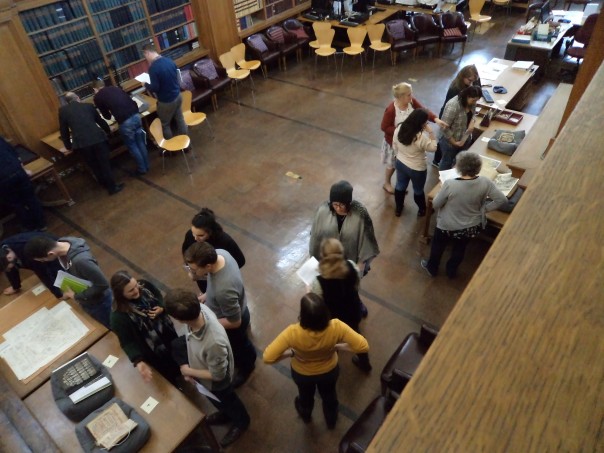
Following on from the end of the blog last week, I’m going to concentrate on the two events which took place this week: the ‘Picture this …’ workshop at Canterbury Cathedral Archives and the joint Centre/FCAT lecture by Professor Chris Pickvance (University of Kent) on Kent’s medieval chests. However before that I want to mention Dean Irwin’s talk to Canterbury Historical and Archaeological Society that is due to take place next week on Wednesday 13 November at 7pm in CCCU, Newton Ng03 when he will be speaking on ‘Acknowledging debt to Jews in 13th century Canterbury: the records of Jewish money lending transactions’. For those reading this and living locally, please do come along CHAS is always delighted to welcome people to its lectures.
Although I wasn’t able to stay for the whole workshop, I did join the Medieval and Early Modern Studies postgraduates from CCCU and Kent when they first arrived at the Cathedral Archives for the workshop hosted by Cressida Williams and her team. After refreshments everyone gathered in the search room where Cressida addressed the postgraduates, as well as the two lead editors from CCCU Dr Diane Heath, and from Kent Dr Rob Gallagher. As she said ‘Picture this …’ has been a very successful joint venture for several years and for 2020 the idea is to raise it even further by having as its year-long theme St Thomas Becket, which also fits in with the other idea for 2020 of the year of cathedrals and pilgrimage – very many English cathedrals will be celebrating their own major saintly anniversaries.
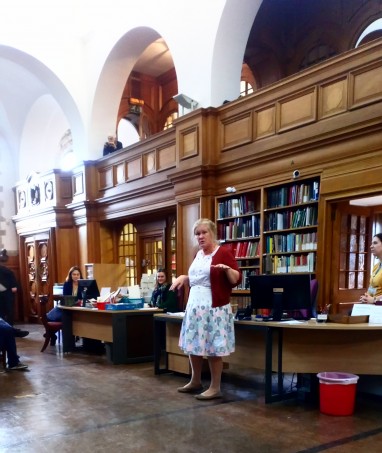
Consequently, all the materials laid out for people to look at in the workshop this year had a Becket focus. Moreover, rather than as in the past confining the monthly ‘Picture this …’ blogs to material from the Cathedral Archives & Library, for the next year at least writers can look wider, perhaps at images in the cathedral itself or in the Beaney or at Rochester Cathedral. In addition, and this is starting next month and thus running for 13 months until December 2020, there will be a few guest writers from outside the two universities. The one for December 2019 being Professor Anne Duggan (King’s College London) who has written on Archbishop Langton’s seal from 1225 which depicts Becket’s martyrdom.
Diane Heath followed Cressida and underlined just how much this had become an important and valued part of the MEMS postgraduate experience at the two universities. She also mentioned that it has now been running for 5 years having been initiated by Karen Brayshaw the then Cathedral Librarian and Dr Jayne Wackett, who had completed her doctoral thesis at Kent and who had very sadly died of a brain tumour earlier this year. Jayne’s principal research focus had been visual culture, and this is an extremely fitting legacy of her time at Kent. Diane also explained that people should see this as a major opportunity to explore something new and that the written pieces they produced, while academically rigorous, should be enjoyable because having fun was important.
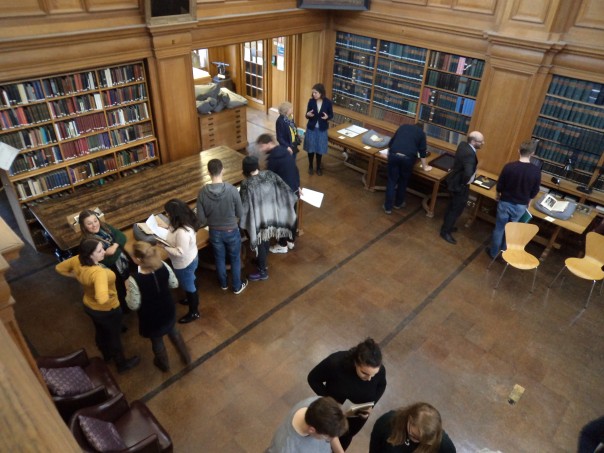
Rob endorsed Diane’s remarks and noted that as peer-reviewed articles they could go on people’s CVs, for as well as Diane, himself and Cressida, Dr Stuart Palmer, the previous Kent lead editor, were there to review articles and to offer constructive comments and suggestions before publication.
At this point Cressida invited the 14 postgraduates to take a closer look at the 12 items she and her team had selected which were laid out on the various tables at one end of the search room. The two oldest items were charters. One of these was the ‘French wine’ charter (c.1180) in which King Philip II of France confirmed his father’s grant of 100 measures of wine in memory of Becket from the castle of Poissy to Canterbury Cathedral Priory. The other late 12th century charter similarly marked a gift linked to Becket, in this case Ingram patric gave an annual payment from his mill at Patrixbourne of 4s to be paid upon the tomb of St Thomas. This grant to God, St Thomas and the monks of Canterbury Cathedral Priory was for Ingram’s soul and the souls of his father, all his ancestors and his heirs.
Among the 20th century objects and images available for the postgraduates was a watercolour (1920-1950) being a copy of the depiction of Becket’s martyrdom as on the tomb of Henry IV and Joan of Navarre. It is thought to be by Ernest William Tristram, who had made a larger copy of the same subject. From about the same period were Becket photos that show the cast from 1932 in Tennyson’s ‘Becket’ that was performed in the Chapter House and at various places in the cathedral. While an even more modern piece Cressida had provided was a Beneagles whisky miniature from the late 1970s which had been supplied by British Caledonian to its 1st class customers. This Becket-shaped whisky container had been part of the chess sets formed by collecting such miniatures.
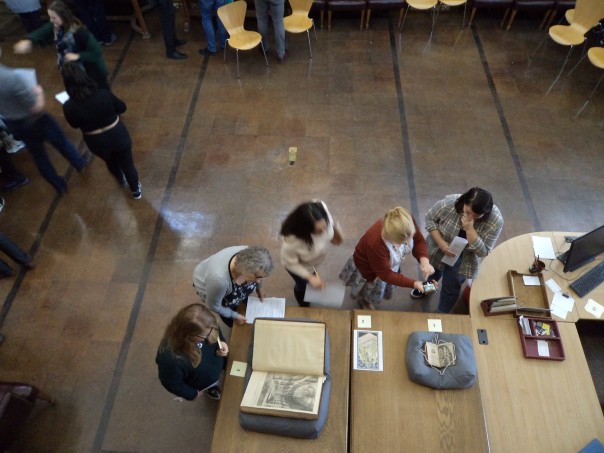
In between were a broad range of items, including Caesar Baronius’ The life or the ecclesiastical historie of S. Thomas Archbishope of Canterbury that was published in 1639 by a woman, the widow of J. Blageart; and John Dart’s The history and antiquities of the Cathedral Church of Canterbury that has amongst several engraving one showing the Corona in the early 18th century.
All this choice was great and almost all the items found an author. The postgraduates will now go off and research their chosen item and then produce their written piece for the editors. Equally exciting a couple of people are going to explore further afield, which means there will be two pieces on different pilgrim badges, while another is going to Rochester Cathedral to see what she can find there. Thus, having had an excellent afternoon, it only remains to thank Cressida, Diane and Rob for organising this year’s ‘Picture this …’ workshop, as well as all the postgraduates for coming along.
Now on to Chris’ talk about Kent’s medieval chests, of which there are several very important ones in Canterbury. Chris began by explaining how he became involved in researching medieval chests and how he has been able to draw on his training in Sociology to derive a systematic approach for his study. Furthermore, even though he has made a special study of chests in Kent to investigate the regional dimension concerning design, construction and type, he has explored far more widely from Derbyshire in the north to Wiltshire and Worcestershire in the west, as well as overseas, including Germany and Poland. Indeed, the importance of Germany is well known and of special significance for England’s eastern counties, including Kent. In addition, he has made a considerable study of the iron work associated with different kinds of chest, especially in relation to different type of hinge and locks. The type of wood used can also provide diagnostic information, while dendrochronology has become increasingly valued as an analytical tool.
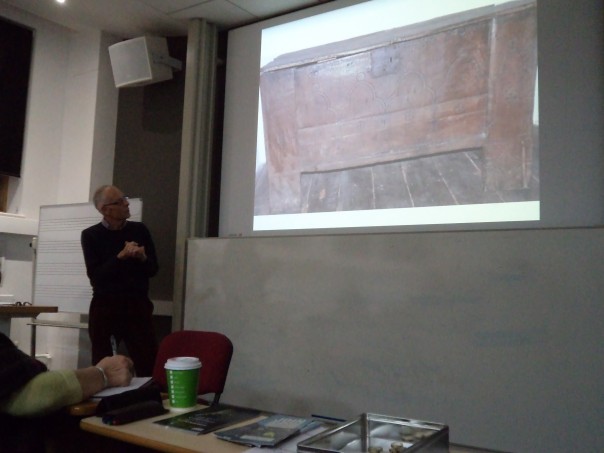
Taking all these issues together, Chris then took his audience through the main medieval types – dugout chests, clamp chests, and frame and panel chests, before finally mentioning the iron bound chests that come towards the end of the period. Moreover, as he noted of these the dugout chests are far commoner in Essex compared to Kent, albeit there are some good examples in Kent such as the chest made of yew at Elham. Nevertheless, he was keen to stress that you should not see it as an evolutionary sequence, rather different construction methods existed simultaneously.
However, it is worth noting that Kent does have a few early 13th century clamp-type examples of which two are at St John’s hospital in Canterbury. As Chris said, the high quality of the carving and the joinery skills on show suggest that this was not a new undertaking in c.1250 (dating from dendrochronology) and thus this chest was part of a long tradition. Consequently, it is worth noting that the hospital has another chest of a similar design which has been dated to about a decade later. Moreover, there is a third chest at St John’s hospital also of the clamp form of construction, albeit it is later, and Chris thinks it is an import from Germany. There are a few other examples of this later form with similarly deeply carved, gothic arcading including one at St Mary’s church, Faversham. This chest also has evidence of paint, probably not an unusual feature originally, but these days finding traces of paint is rare.
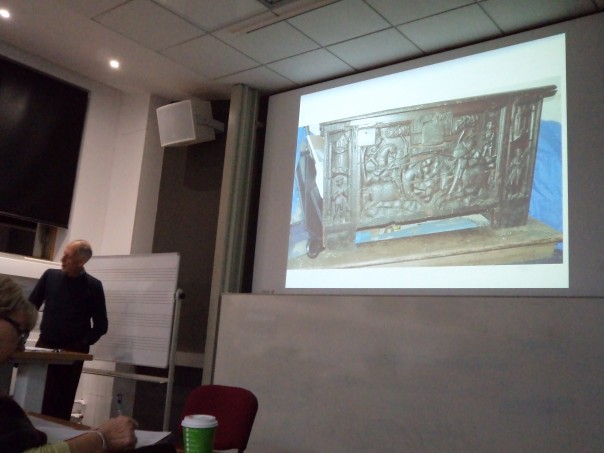
Other excellent examples from Kent that Chris showed included an extremely large highly decorated chest in the parish church at Hythe, which as well as having gothic arches and roundels has mythical bests at the ends, and there are others of this design in northern England. The chest at Harty is even better known for its carving, and this Flemish-made late 14th-century chest shows a jousting scene. Different again is the chest at St Nicholas’ hospital at Harbledown, which is another very large item, its lid is made of limewood.
As Chris said, one of the problems is trying to match the documentary evidence to the surviving chests and often little is known about the provenance, especially the early history, including what was stored in such chests – vestments, but also books and other muniments, and silverware. Yet there are some valuable sources such as churchwardens’ accounts, inventories, chantry certificates, ordinances and wills, while documents such as custumals highlight the possession and use of civic chests, such as the Sandwich custumal that says the civic chest was taken annually to the new mayor’s house, albeit a later documentary record suggests that at some stage it was stored at St Peter’s church in the town. Such a chest, like those in parish churches and religious houses often had multiple locks and keys.
Chris finished his fascinating talk by mentioning the iron bound chests that continued into the 16th century and beyond. After very warm applause, Chris answered a variety of questions that again demonstrated the depth and breadth of his knowledge. Furthermore, even after the official end of the lecture Chris took more questions and when I left the lecture theatre, he was still talking to those who wanted more information. For those who would like to know more, Chris had published numerous articles, including two in Archaeologia Cantiana in 2015 and 2017 , now available on the Kent Archaeological Society website.
To round off this week, I thought I would just thank all the CCCU History postgraduates who came to ‘Picture this …’ and remind you that Dean Irwin will be speaking next Wednesday as the CHAS lecturer.
 Centre for Kent History and Heritage
Centre for Kent History and Heritage Sheila Sweetinburgh
Sheila Sweetinburgh 1496
1496

